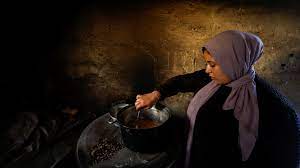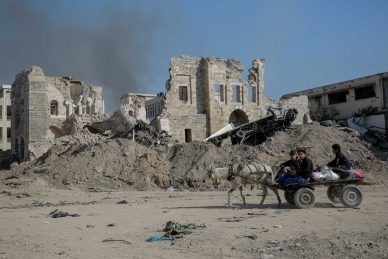Preparations for the upcoming celebration and festivities of Eid Al-Adha (Feast of the Sacrifice) in the besieged Gaza Strip started a few days before the first day of Eid. Eid Al-Adha is an eagerly-awaited event by Palestinians in Gaza for whom opportunities to celebrate are rare. During Eid Al-Adha which marks the end of the Muslim pilgrimage (Hajj) Muslims everywhere sacrifice acceptable livestock to mark reverence to Prophet Abraham’s compliance to sacrifice his son Ismail on Allah’s command.
During prayers people join in recitation of Takbeer of the same phrase in unison. “The sound of people gathering and reciting Takbeer is awe-inspiring and fills the heart with joy and cheerfulness” says Haj Khadir Khdair 66. “Sometimes we start reciting Takbeer days before Eid and tour the streets or in the mosques” Khadir says. “Some areas also broadcast Takbeer on televisions and radios.” Takbeer continues for the duration of the four-day Eid.
Days before Eid Al-Adha the markets are crowded with people preparing for the celebration. Families buy new clothes traditional sweets and nuts. Some families prepare Ka’ek and other traditional sweets at home. “During Eid Al-Adha my family traditionally doesn’t make sweets as it is a meat holiday but our neighbors never let an Eid pass without making Ka’ek or Ma’moul” Haj Khadir says.
On the first day of Eid Palestinian families flock to open areas to pray and recite Takbeer in unison. They then return home in order to perform the rite of livestock sacrifice which is then distributed; a portion of the meat goes to the poor and a portion will be eaten by family friends and neighbors.
Eid Al-Adha is unique from Eid Al-Fitr and one of the strong distinguishing features is the “widespread use of fire and the smell of cooking Saj bread and fried meat across Palestine” Haj Khadir says. He added “Saj bread is an essential part of traditional Palestinian breakfast during Eid Al-Adha which includes the sheep’s liver and kidney.”
Some Palestinian families mark the occasion by preparing Saj bread and distributing it to relatives and neighbors or by gathering together and cooking in the same location. In a scene resembling a wedding ceremony amidst a gathering of adults and children and in every alley street and courtyard of houses smoke rises from the fires that make the Saj bread.
However a large majority of Palestinian people are celebrating under hardships exacerbated by soaring inflation and food prices due to the ongoing air land and sea Israeli siege and the repeated Israeli aggressions.
“The sales of sacrificial animals witnessed a significant increase this year compared to previous years despite the high prices” says Abu Antar Abu Hasanain the owner of one of livestock warehouses in Khan Younis. According to Abu Hasanain a large number of those who bought the sacrificial animals this year paid for them in installments a signifier of the difficult economic conditions the residents of the Gaza Strip are living through. He explained that the purchaser can divide the price of the sacrifice over several months according to their monthly income. The ministry of agriculture pointed out that the ministry imports animals and fodder due to the limited agricultural space in Gaza which is barely sufficient for vegetables and fruit trees which is the justification for such high prices.
Abu Hasanain explained that the ministry imports through the Egyptian crossing or through the crossing with Israel and is not allowed direct entries from producing countries such as Australia or New Zealand adding “If we had this opportunity the sheep in Gaza would sell for one hundred dollars but currently it costs around $460.”
For some families it is customary to express their loyalty and love for their beloved ones who have passed away or have been martyred by the occupation by visiting graveyards and watering the flowers. This is one of the customs typical for the 1st day of Eid or the day before. It is also traditional for people to distribute sweets for visitors at the graveyards and nearby streets.













